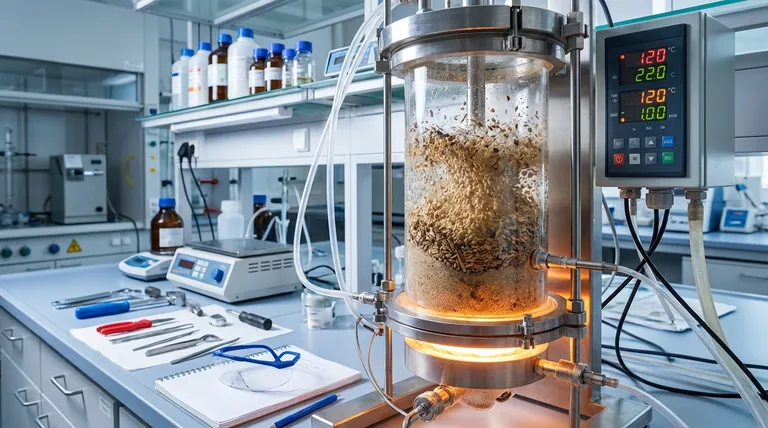In essence, a fluidized bed reactor is a specialized vessel that uses an upward-flowing gas to suspend a bed of solid particles, causing the mixture to behave like a boiling fluid. This "fluidized" state is not just for mixing; its primary purpose is to create an environment of exceptionally uniform temperature and rapid heat transfer, which is critical for controlling chemical reactions.
The core advantage of a fluidized bed reactor is its ability to master temperature control. By turning a static bed of solids into a dynamic, fluid-like system, it eliminates dangerous hot spots and ensures that every particle of the material being processed experiences the exact same conditions, leading to a more consistent and higher-quality product.

The Core Principle: How Fluidization Works
A fluidized bed reactor's design is elegantly simple but highly effective. It combines a few key elements to create its unique operational state.
Key Components
The reactor consists of a vessel containing a bed material, which is typically an inert, granular solid like sand. The material to be processed, known as the substrate (e.g., small particles of biomass), is introduced into this bed.
Achieving the "Fluid-Like" State
A fluidizing gas, often an inert gas like nitrogen, is forced upward through a distributor plate at the bottom of the vessel. When the velocity of this gas is high enough, its upward force counteracts gravity, causing the solid particles of the bed material and substrate to become suspended and circulate vigorously.
This agitated, suspended state is what is known as fluidization. The entire mixture of gas and solids flows and behaves like a liquid.
Key Advantages in Chemical Processing
The fluid-like behavior is the source of the reactor's primary benefits, making it superior for certain types of reactions, particularly those that are highly sensitive to temperature.
Unmatched Heat Transfer
The constant, rapid motion of the bed particles ensures that heat is transferred from the reactor walls to the substrate with extreme efficiency. The sand or other bed material acts as a massive thermal reservoir, distributing energy evenly and instantly.
Precise Temperature Control
This efficient heat transfer eliminates temperature gradients and prevents the formation of "hot spots" within the reactor. In many chemical processes, such as pyrolysis, even small temperature variations can lead to unwanted side reactions and a lower yield of the desired product.
Controlled Reaction Atmosphere
The gas used for fluidization serves a dual purpose. By using an inert gas like pure nitrogen, the reactor maintains an oxygen-free atmosphere. This prevents unwanted oxidation or combustion of the substrate, ensuring the desired chemical transformation occurs without interference.
Understanding the Trade-offs: Fluidized Bed vs. Fixed Bed
To fully appreciate the role of a fluidized bed reactor, it is helpful to contrast it with a more conventional design: the fixed-bed reactor.
The Fluidized Bed Advantage
As discussed, the strength of the fluidized bed is its dynamic nature. It excels with particulate substrates and processes that demand uniform temperature. This leads to higher yields of specific byproducts, such as bio-oils and gases in biomass pyrolysis.
The Fixed Bed Alternative
In a fixed-bed reactor, the solid material (which may be a catalyst) is held stationary in a packed "bed," and the gas or liquid flows through it. This design is mechanically simpler but is prone to developing significant temperature gradients, as heat does not transfer as efficiently through the static particles.
Common Applications and Outcomes
The unique properties of fluidized bed reactors make them indispensable in several key industries.
Biomass Pyrolysis
This is a flagship application. Fluidized beds are highly effective for converting particulate substrates like woody biomass into valuable bio-oils and synthesis gas. The precise temperature control is crucial for maximizing the liquid fuel yield.
Petroleum and Chemical Industries
These reactors are widely used in a variety of large-scale industrial processes, including gasoline production (Fluid Catalytic Cracking), catalyst regeneration, and the synthesis of chemicals where uniform conditions are paramount to safety and product quality.
Making the Right Choice for Your Goal
Selecting the correct reactor type depends entirely on the specific requirements of your chemical process.
- If your primary focus is maximizing yield from a temperature-sensitive reaction: The superior heat transfer and uniform temperature profile of a fluidized bed reactor make it the definitive choice.
- If your primary focus is on a mechanically simpler process that is not sensitive to temperature variations: A fixed-bed reactor may offer a more straightforward and cost-effective solution.
Ultimately, the fluidized bed reactor is a powerful engineering tool designed to exert precise control over the challenging thermal and chemical environments of modern industrial processes.
Summary Table:
| Feature | Fluidized Bed Reactor | Fixed Bed Reactor |
|---|---|---|
| Temperature Uniformity | Excellent (eliminates hot spots) | Prone to gradients |
| Heat Transfer Efficiency | Very High | Moderate |
| Process Atmosphere Control | Excellent (using inert gas) | Good |
| Ideal For | Temperature-sensitive reactions, particulate substrates | Simpler processes, less sensitive reactions |
Ready to achieve precise temperature control and superior product yields in your lab?
KINTEK specializes in high-performance lab equipment, including reactor systems designed for efficient chemical processing. Whether you are working on biomass pyrolysis, catalyst testing, or other temperature-sensitive reactions, our expertise can help you select the right solution to enhance your research and development.
Contact our experts today to discuss how our reactor technology can benefit your specific application!
Visual Guide

Related Products
- Mini SS High Pressure Autoclave Reactor for Laboratory Use
- Customizable High Pressure Reactors for Advanced Scientific and Industrial Applications
- High Pressure Laboratory Autoclave Reactor for Hydrothermal Synthesis
- Stainless High Pressure Autoclave Reactor Laboratory Pressure Reactor
- Electrolytic Electrochemical Cell Gas Diffusion Liquid Flow Reaction Cell
People Also Ask
- What is a high pressure autoclave? A Complete Guide to High-Temp, High-Pressure Reactors
- Why is an autoclave the most effective sterilizer? Unlock the Power of Pressurized Steam for Guaranteed Sterility
- What is a high pressure high temperature autoclave reactor? Unlock Extreme Chemical Synthesis
- What is a high pressure reactor? Your Guide to Safe, High-Yield Chemical Reactions
- How is high pressure generated in an autoclave? Unlock the Science of Sterilization & Synthesis



















